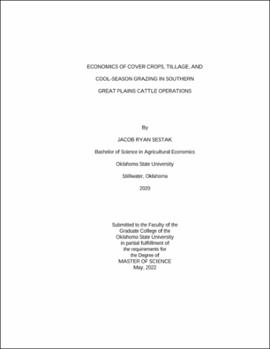| dc.contributor.advisor | Brorsen, B. Wade | |
| dc.contributor.author | Sestak, Jacob Ryan | |
| dc.date.accessioned | 2023-03-17T21:06:38Z | |
| dc.date.available | 2023-03-17T21:06:38Z | |
| dc.date.issued | 2022-05 | |
| dc.identifier.uri | https://hdl.handle.net/11244/337135 | |
| dc.description.abstract | The first essay evaluates the usage of tillage and summer cover crops in stocker cattle operations. No-till establishment and cover crops are promoted to improve soil health and profitability. Data from a five year, completely randomized experiment are used in mixed-effects regression models to estimate the effects of tillage establishment method and the use of summer cover crops relative to a summer fallow. Enterprise budgeting was used to determine the relative net returns of the investigated systems. One-way analysis of variance models suggest that total bodyweight gain ha-1 was significantly higher in no-till established winter pastures with a summer fallow at the 95% confidence level. No-till and summer fallow paddocks realized lower machinery costs associated with pasture establishment, giving such a system an economic advantage. Additional revenues from grazable summer cover crops did not outweigh additional costs in seed, fuel, and chemical applications. Overall, no-till established winter wheat pasture with a subsequent summer fallow was the most economical system.The second essay evaluates grazing season extension in bermudagrass pastures through stockpiled bermudagrass, winter annual crops, and summer annual crops. Data from a four year, completely randomized experiment are used in a mixed effects regression analysis to estimate the effect of warm-season forage stockpiling and summer and winter annual forage crops on 205-day adjusted calf weaning weights and total kg of hay and cube supplement fed per month. Enterprise budgeting was used to model the experiment and find the most economical system. Calf birth weight, adjusted calf weaning weights, and cow body condition score prior to breeding did not differ between systems at the 95% confidence level. Total cubes fed per month was significantly higher in the conventional bermudagrass pasture with hay and cube supplement system, and hay fed per month was significantly higher in a bermudagrass pasture with bermudagrass stockpile and warm and cool-season annual cropland acres. Increased machinery costs, seed costs, and fertilization requirements associated with bermudagrass stockpiling and warm and cool-season annuals outweighed any feed cost savings. As a result, the conventional bermudagrass pasture with hay and cube supplement system produced the highest expected net returns. | |
| dc.format | application/pdf | |
| dc.language | en_US | |
| dc.rights | Copyright is held by the author who has granted the Oklahoma State University Library the non-exclusive right to share this material in its institutional repository. Contact Digital Library Services at lib-dls@okstate.edu or 405-744-9161 for the permission policy on the use, reproduction or distribution of this material. | |
| dc.title | Economics of cover crops, tillage, and cool-season grazing in southern Great Plains cattle operations | |
| dc.contributor.committeeMember | Biermacher, Jon T. | |
| dc.contributor.committeeMember | Rogers, James K. | |
| osu.filename | Sestak_okstate_0664M_17566.pdf | |
| osu.accesstype | Open Access | |
| dc.type.genre | Thesis | |
| dc.type.material | Text | |
| dc.subject.keywords | cover crops | |
| dc.subject.keywords | economics | |
| dc.subject.keywords | forage stockpiling | |
| dc.subject.keywords | soil health | |
| dc.subject.keywords | tillage | |
| dc.subject.keywords | wheat forage | |
| thesis.degree.discipline | Agricultural Economics | |
| thesis.degree.grantor | Oklahoma State University | |
